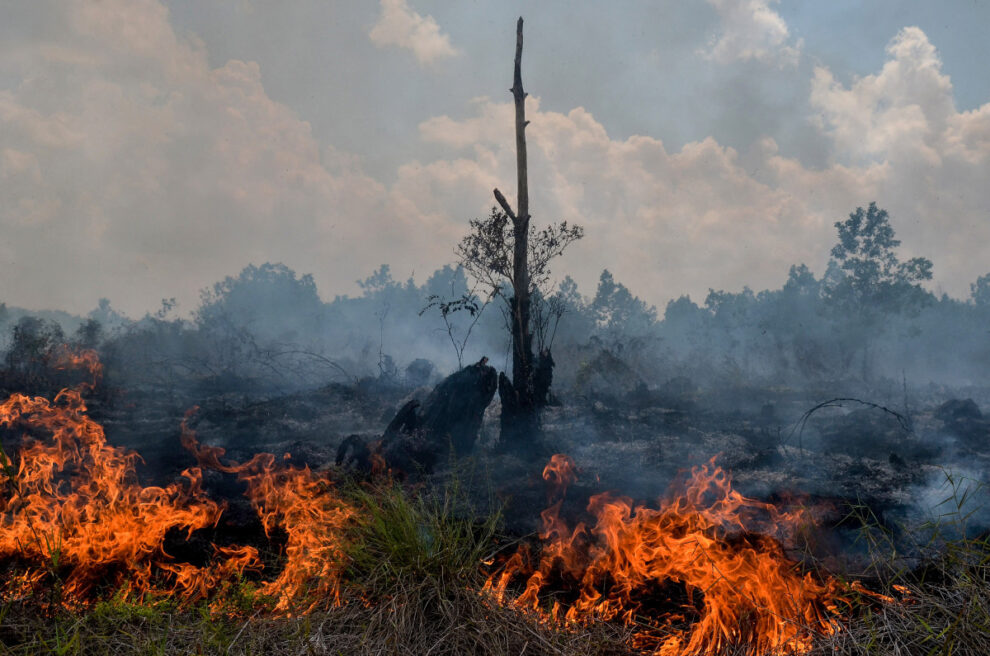One hot night in Roboré, a town in Bolivia’s eastern lowlands, the community leader Rubén Darío Arias was hunched over a laptop, smoking intensely as he pointed to the red spots where forest fires were breaking out all over the map.
This was in September 2022 – but it could have been any other recent year. Large forest fires are now an annual phenomenon in Bolivia – cause and effect of the deforestation linked to its booming agribusiness.
Bolivia’s deforestation has long flown under the radar. That changed when Bolivia reportedly blocked a pledge to end deforestation by 2030 at the Amazon summit in August. But a closer look at the forces driving it leads to an unsettling conclusion: everything points to more, not less, deforestation to come.
Scaled to population, Bolivia’s deforestation is four times that of Brazil. Even as Brazil’s deforestation falls, Bolivia’s is rising. Its loss rate of primary forest jumped by 32% from 2021 to 2022, according to Global Forest Watch.
Most of this is happening in Santa Cruz, Bolivia’s most economically dynamic region, where most of its soya and beef, as well as its sugar cane, corn and sorghum, is produced.
Santa Cruz is also home to the Chiquitanía, a dry forest ecosystem that is part of the Amazon watershed. Almost a quarter of it has been deforested since 1985.
“Santa Cruz has a vision of development that is very marked by intensive agriculture,” says Alcides Vadillo, director of Fundación Tierra, an NGO. “We are seeing how capital and machinery can change forest into productive lands.”
Soya farming is the most significant driver of deforestation in Bolivia. In 2022, soya and its derivates were Bolivia’s third largest export, generating revenues of more than $2bn. A study by Trase, which analyses supply chains, found that Bolivian soya production was linked to exceptionally high amounts of deforestation compared with neighbouring soya producers Brazil, Argentina and Paraguay.
Anapo, the industry organisation for Bolivia’s soya farmers, denies that the sector is responsible for deforestation, saying that the surface area dedicated to soya farming has barely increased in recent years. But Stasiek Czaplicki, an environmental economist who contributed to the Trase report, says this a sleight of hand. New lands are continually being deforested and sown with soya for a few years, with diminishing yields, until they are given over to another activity, such as low-intensity ranching. So, the overall surface area might not be rising – but the sector is still driving deforestation.
In Bolivia, it is cheaper to buy forest land and turn it into farmland than to invest in existing farmland to improve its productivity and longevity. Moreover, that land will appreciate in value – which hints at the thriving business behind agriculture in Santa Cruz.
“The soya business isn’t really a soya business,” says Czaplicki. “It’s the business of land.”
Land is still cheap in Bolivia – much more affordable than in neighbouring countries – but continually increasing in value as Bolivia becomes more integrated into regional and international markets. It also costs relatively little to deforest that land, said Vadillo, because the Bolivian state heavily subsidises fuel – and deforesting land can double or triple its value.
“In the 90s, forest land in Bolivia could be bought for perhaps $20 to $70 per hectare,” said Czaplicki. “Today, that land might be worth almost $1,000 per hectare. Imagine if you invested in the 90s and were selling that land today. The profits are extraordinary – I can’t think of any other legal business like it.”
The expansion of the agricultural frontier has been a rare point of agreement between the central government in La Paz, led by the Movimiento al Socialismo (Mas) almost without interruption since 2006, and the economic elite in Santa Cruz, who are otherwise rivals on either side of an old regional divide. Santa Cruz has long pushed for greater decentralisation.
“That alliance has been explicit,” says Enrique Ormachea, an investigator at the thinktank CEDLA. “The Mas never did a serious agrarian reform that would affect the property of the big landowners in Santa Cruz. Instead, they agreed on expanding the agricultural frontier for exports.”skip past newsletter promotion
Get a different world view with a roundup of the best news, features and pictures, curated by our global development team
The Mas has specifically sought to incorporate more smallholders into the supply chain by handing out public lands for nothing to settlers. But its policies have also boosted production by larger landowners and the more than 120 Mennonite colonies throughout Bolivia.
Aside from building infrastructure and keeping taxes on agricultural goods and machinery low, the government has increased the amount of land that can be legally deforested, and retrospectively pardoned illegal deforestation.
Illegal deforestation is rarely penalised. And when it is, the fines are risible: 20¢ a hectare, compared with hundreds of dollars a hectare in neighbouring countries.
The Mas still has big plans for the sector. It wants to produce palm oil in Bolivia, boost beef exports to China and build biodiesel refineries that would use Bolivian produce – all of which would be a boon to agribusiness in Santa Cruz. But this isn’t simply an elite pact: there is deep support throughout Santa Cruz for expanding the agriculture frontier.
This can be seen at ExpoCruz, the region’s annual business fair. It is also a week-long party that coincides with Santa Cruz Day on 24 September, where the region’s economic growth and identity are presented as synonymous with agribusiness. The whole city seems to turn out to celebrate. Families and couples stroll through hangars full of cattle, while farm smells mingle with grilled meat.
The “Cruceño model”, which claims to explain the region’s growth, is on everyone’s lips. It emphasises the entrepreneurship, self-reliance and liberal spirit of the lowlands – epitomised by farming and ranching – and plays down the critical role of state investment.
This, says Czaplicki, is part of a search for regional identity, as Bolivia’s lowlands define themselves against Andean highlands. “Turn on the radio, open a newspaper, and you won’t find anything to the contrary. It is almost politically incorrect to question it.”
Partly as a result, none of the local or national political parties are against expanding the agricultural frontier – nor is there yet a groundswell of popular resistance that could change that. Meanwhile, beyond the fair, in places like Roboré, the consequences are being felt in the form of drought and degraded soil, displaced communities and more frequent and intense forest fires.
“But still, the model expands,” says Czaplicki. “We’re heading towards a situation of cyclic water crises, loss of biodiversity and ever greater environmental pollution.
Source : The Guardian
















